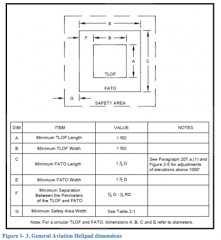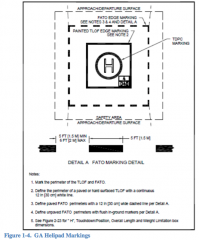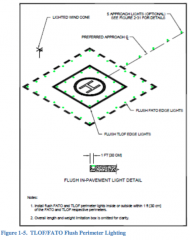![]()
![]()
![]()
Use LEFT and RIGHT arrow keys to navigate between flashcards;
Use UP and DOWN arrow keys to flip the card;
H to show hint;
A reads text to speech;
59 Cards in this Set
- Front
- Back
|
What the parameters are used to classify the Design Aircraft? |
The _______ represents a collection of aircraft classified by three parameters: Aircraft Approach Category (AAC), Airplane Design Group (ADG), and Taxiway Design Group (TDG). |
|
|
What is the Runway Design Code (RDC)? |
Airport design criteria predicated on the ______ will affect the spacing and layout of runways and taxiways, the location of navigational aids, the height and location of the terminal and other buildings, and the dimensions of various safety areas, runway protection zones, and other areas. To a larger degree, these _____ standards include dimensional and strength criteria to which the airport facilities must be built, necessary markings and lighting, and navigational aids that may be required |
|
|
What is the Aircraft Approach Category (AAC)? |
The first component of the Runway Design Code (RDC), and it relates to aircraft approach speed (operational characteristic). Specifically, this relates to the reference landing speed (VREF), if specified, or if VREF is not specified, 1.3 times the stall speed of the aircraft at the maximum certificated landing weight (Table 1-1). |
|
|
What is Aircraft Approach Category A? |
Approach speed: Less than 91 knots |
|
|
What is the Airplane Design Group (ADG)? |
The second component of the Runway Design Code (RDC), depicted by a Roman numeral, and relates to the airplane wingspan and tail height (physical characteristics) of the largest aircraft expected to operate on the runway and adjacent taxiways. When the aircraft wingspan and tail height for an aircraft fall in different groups, the higher group issued. |
|
|
What is Airplane Design Group I? |
Tail Height: <20 Wingspan: <49 |
|
|
What are Approach Visibility Minimums? |
The third component or RDC, depicted in RVR values, relates to the _______ expressed by RVR values in feet of 1200, 1600, 2400, 4000, and 5000 (corresponding to lower than 1/4 mile, lower than 1/2 mile but not lower than 1/4 mile,lower than 3/4 mile but not lower than 1/2 mile, lower than 1 mile but not lower than 3/4mile, and not lower than 1 mile, respectively). |
|
|
What is the Taxiway Design Group (TDG)? |
Based on the overall Main Gear Width (MGW) and the Cockpit to Main Gear Distance (CMG). |
|
|
Factors affecting Runway locations: Wind |
Velocity and direction as related to the existing and forecasted operations during visual and instrument meteorological conditions. It may also consider ______ by time of day. Minimum 95% _____ coverage required.
|
|
|
What are the Allowable Crosswind Component per Runway Design Code? |

|
|
|
What are Runway Shoulders? |
Provide resistance to jet blast erosion, and accommodate the passage of maintenance and emergency equipment, as well as the occasional passage of an airplane veering from the runway. Airports serving large, four-engine jet aircraft will often have paved _____, whereas smaller airports may have grass _____. The ________ will have a 1.5% to 5% slope to ensure the same. |
|
|
What are Runway Visibility Zones (RVZ)? |
The ______ is an area formed by imaginary lines connecting the visibility points of two different runways. Calculated to allow adequate time for one aircraft to see and avoid an aircraft using the other runway, and to restrict the placement of objects or buildings within the zone. |
|
|
What is the Runway Threshold? |
The beginning or end of the full-strength runway pavement or surface that is available for landing or takeoff. |
|
|
What is a Taxiway? |
Defined surface path used for aircraft that link the independent airport elements and provide for free movement to and from the runways, terminal and cargo areas, and parking areas. |
|
|
What is an apron? |
Provide access to terminal facilities, places for loading and unloading, means for fueling, and space for surface transportation. |
|
|
What are Azimuth Guidance for Nose-in Stands (AGNIS) and Parallax Aircraft Parking Aids (PAPA)? |
Fixed guidance markers designed to guide different aircraft into a terminal gate docking station. |
|
|
What are Advanced Visual Docking Guidance Systems (AVDGS)? |
At some major airports, _____________ are installed that provide electronically displayed information, such as the azimuth position of the aircraft and stopping distance. |
|
|
How are helicopters useful to the aviation system? |
Helicopters have proven useful to communities in the following ways:
|
|
|
What is Helipads and Heliports and Helipads? |
_________ are clearly marked landing areas for helicopters, where as __________ would contain one or more __________, as well as fuel and service facilities for helicopters. |
|
|
General Aviation Helipad Dimensions |

|
|
|
What is a Heliport Protection Zone (HPZ)? |
The area under the approach/departure path starting at the FATO perimeter and extending out for a distance of 280 feet for GA facilities and 400 feet for transport facilities. In the event of an engine failure, the ____________ provides an emergency landing site that would minimize the risk of injury or damage to property on the ground. |
|
|
GA Helipad Markings |

|
|
|
What are Heliport Markers and Markings? |
Heliport markers and markings include:
|
|
|
TLOF/FATO Flush Perimeter Lighting |

|
|
|
Heliport Lighting |
Heliport lighting includes:
|
|
|
What is Aircraft Approach Category B? |
Approach Speed: 91 knots or more but less than 121 knots |
|
|
What is Aircraft Approach Category C? |
Approach Speed: 121 knots or more but less than 141 knots |
|
|
What is Aircraft Approach Category D? |
Approach Speed: 141 knots or more but less than 166 knots |
|
|
What is Aircraft Approach Category E? |
Approach Speed: 166 knots or more |
|
|
What is Airplane Design Group II? |
Tail Height: 20 - <30 Wingspan: 49 - <79 |
|
|
What is Airplane Design Group III? |
Tail Height: 30 - <45 Wingspan: 79 - <118 |
|
|
What is Airplane Design Group IV? |
Tail Height: 45 - <60 Wingspan: 118 - <171 |
|
|
What is Airplane Design Group V? |
Tail Height: 60 - <66 Wingspan: 171 - <214 |
|
|
What is Airplane Design Group VI? |
Tail Height: 66 - <80 Wingspan: 214 - <262 |
|
|
Factors affecting Runway locations: Airspace Availability |
Existing and planned instrument approach procedures,missed approach procedures, departure procedures, control zones, special useairspace, restricted airspace, and traffic patterns. |
|
|
Factors affecting Runway locations: Environmental Factors |
Impacts of existing and proposed land use and noise on nearby residents, air and water quality, wildlife, and historical/archeological features. |
|
|
Factors affecting Runway locations: Obstructions to Air Navigation |
Identify those objects which may affect airplaneoperations. Approaches free of obstructions are desirable and encouraged, but as aminimum, locate and orient runways to ensure that the approach areas associated with the ultimate development of the airport are clear of hazards to air navigation. |
|
|
Factors affecting Runway locations: Topography |
_______ affects the amount of grading and drainage work required to construct a runway. In determining runway orientation, costs of boththe initial work and ultimate airport development should be considered. |
|
|
Factors affecting Runway locations: Airport Traffic Control Tower Visibility |
Existing (or future) ________ must have a clear line of sight to all traffic patterns, the final approaches to all runways, all runway structural pavement, and other operational surfaces controlled by _____. A clear line of sight to taxilanecenterlines is desirable. Operational surfaces not having a clear unobstructed lineof sight from the ______ are designated as uncontrolled or non-movement areas through a local agreement with the airport owner. |
|
|
Factors affecting Runway locations: Wildlife Hazards |
The relative locations of bird sanctuaries, sanitary landfills, or other areas that may attract large numbers of birds or wildlife should beconsidered. Where bird hazards exist, develop and implement bird control procedures to minimize such hazards. |
|
|
Why do runways normally have a 1% to 5% cross section grade? |
To ensure sufficient water runoff. |
|
|
What is a Displaced Runway Threshold? |
A _______ does not begin at the start of full-strength runway pavement; instead, it is located some distance down the runway. Requires aircraft to be at a higher altitude than normal on final approach. |
|
|
Why are some Runway Thresholds displaced? |
To ensure a landing aircraft has adequate clearance over objects in the approach path: 1. When an object obstructs the airspace needed for landing aircraft. 2. When there are environmental considerations, such as noise abatement. 3. When runway safety area dimensions or obstacle-free area lengths are needed. |
|
|
What is a Taxilane? |
Portion of an aircraft parking area used for access between taxiways and aircraft parking positions or may be used as a “taxiway” not under ATC control. Typically, _________ are not part of the movement area. |
|
|
What three parameters are used to form the Runway Design Code (RDC)? |
The Aircraft Approach Category (AAC), Airplane Design Group (ADG), and approach visibility minimums are combined to form the _________ of a particular runway. |
|
|
What is FAA Form 5010-1? |
Airport Master Record, contains aeronautical data describing the physical and operational characteristics of civil public-use airports, joint-use military airports, and private-use military airports that are active and in the NAS. It contains airport data derived from the National Airspace System Resources (NASR) database as of the AFD effective date shown on the form. |
|
|
What is FAA Form 5010-3? |
Airport Master Record, is a blank form used by FAA, State, and contractor airport inspectors and other Regional Airports Division/ADO personnel to provide the initial physical inspection report on a newly constructed or newly reported civil public-use airport. |
|
|
Does Part 139 apply to heliports/helipads? |
No, Heliports and Helipads are not included in Part 139. |
|
|
What are the basic elements of a Heliport? |
The _______ of a _________ are clear approach and departure paths, a clear area for ground maneuvers, and a windsock. |
|
|
What is the Touch-down and Lift-off area (TLOF)? |
The ______ should be located and designed to provide ready access to the airport terminal or to the helicopter user’s origin or destination. May be at ground level, on an elevated structure, or at rooftop level. At a minimum, the size of the _____ should at least equal the rotor diameter of the design helicopter intended for the helipad. |
|
|
What are the two categories of Heliports? |
General Aviation and Transport Helicopters? |
|
|
What is a General Aviation Heliport? |
A _____________ heliport accommodates helicopters used by individuals,corporations, and helicopter air taxi services. |
|
|
What is a Transport Heliport? |
A ______________ is intended to accommodate air carrier operators providing scheduled service, or unscheduled service with large helicopters. |
|
|
What is the Final Approach Takeoff Area (FATO)? |
Contains a TLOF within its borders at which arriving helicopters terminate their approach and from which departing helicopters take off. The minimum width, length, or diameter of a _____ must be at least 1.5 times the overall length (D) of the design helicopter. Can be circular or rectangular, regardless of the shape of the TLOF. |
|
|
Markings for the TLOF? |
Marked with a white “H” marking. If paved, the perimeter is marked with a continuous 12 inch wide white line. If unpaved, the perimeter is marked with a series of 12 inch wide, flush,in-ground markers. The perimeter of a load-bearing FATO should be defined by markers and/or lines. Forpaved FATOs, the perimeter is defined by a 12 inch wide dashed, white line. UnpavedFATOs are marked with 12-inch wide flush, in-ground markers. An optional flight pathalignment guidance marking consists of one or more arrows to indicate the preferredapproach/departure directions, placed on the TLOF, FATO and/or safety area surfaceusing a color which provides good contrast against the background color of the surface. |
|
|
What is a touchdown/positioning circle (TDPC)? |
A yellow circle with an inner diameter of 1⁄2 D (one-half overall length) and a line width of 18 in and located in the center of a TLOF. |
|
|
Markings for the FATO? |
The perimeter of a _______ should be defined by markers and/or lines. If paved, the perimeter is defined by a 12 inch wide dashed, white line. If unpaved, it is marked with 12-inch wide flush, in-ground markers. |
|
|
Lighting for the TLOF? |
Perimeter is outlined with flush green lights. Lights should be spaced at a maximum of 25 feet. Optionally, raised, omnidirectional _____ perimeter lights may also be used, as long as they do not penetrate a horizontal plane at the FATO elevation by more than two inches. |
|
|
Lighting for the FATO? |
Green lights define the perimeter of the load-bearing ______. A minimum of four lights must be used, typically with one at each corner and additional lights uniformly spaced between the corner lights at no more than 25 feet apart. |

